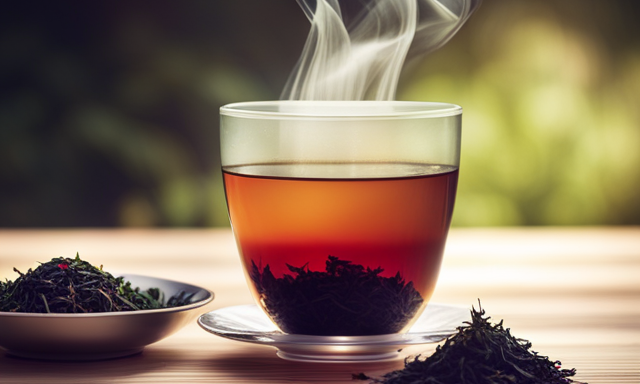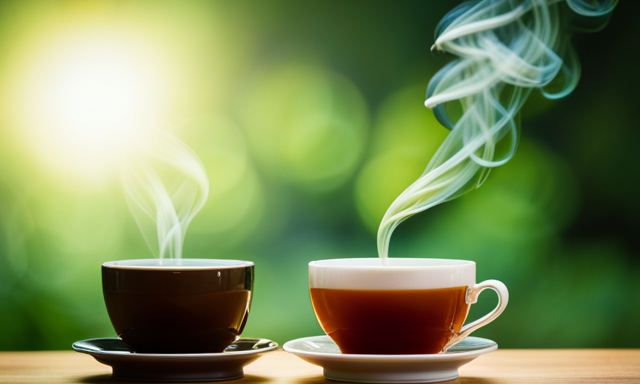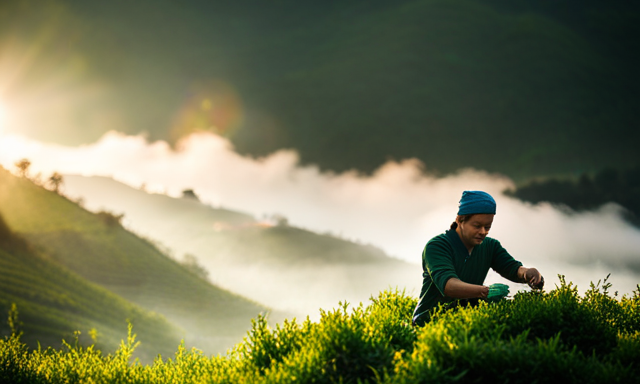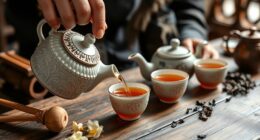Did you know that oolong tea is made from the leaves of the Camellia sinensis plant, just like green tea and black tea? It’s true! Oolong tea is a unique variety of tea that falls somewhere between the freshness of green tea and the richness of black tea.
With its distinct flavor profiles and health benefits, oolong tea has gained popularity not only in China, but also around the world. In this article, I will take you on a journey to explore the origins of oolong tea, the different types available, and the fascinating process of oxidation that gives it its characteristic taste.
We will also delve into the cultural significance of oolong tea in China and discover the wide array of oolong tea varieties waiting to be explored. So grab a cup of oolong tea and let’s dive into the world of this exquisite beverage!
Key Takeaways
- Oolong tea is made from the leaves of the Camellia sinensis plant.
- Oolong tea undergoes a unique partial oxidation process, resulting in its distinct flavors.
- There are different types of oolong tea, including lightly oxidized, moderately oxidized, and darkly oxidized varieties, each with their own flavor profiles.
- The leaves used in oolong tea are sourced from high-quality Camellia sinensis plants and undergo various processing techniques such as withering, rolling, and oxidation, which contribute to the unique characteristics of oolong tea.
The Origins of Oolong Tea
So, you’re probably wondering where oolong tea comes from, right? Well, let me tell you that it’s made from the leaves of the Camellia sinensis plant, just like black and green tea.
The origins of oolong tea can be traced back to ancient China, where tea cultivation has been practiced for thousands of years. Oolong tea is unique because it undergoes a partial oxidation process, which gives it a distinct flavor and aroma. This process involves withering the leaves under the sun and then gently bruising them to start the oxidation.
The leaves are then carefully oxidized and dried to achieve the desired level of oxidation. Different regions in China have their own unique methods of producing oolong tea, resulting in a wide variety of flavors and characteristics.
Now, let’s move on to the different types of oolong tea.
The Different Types of Oolong Tea
When it comes to oolong tea, there are three main types that differ based on the level of oxidation they undergo.
Lightly oxidized oolong teas are known for their delicate and floral flavors, with a range of green to yellowish-brown leaves.
Moderately oxidized oolong teas offer a balance between the light and dark varieties, resulting in a smooth and fruity taste, often with hints of honey or caramel.
On the other hand, darkly oxidized oolong teas are known for their robust and rich flavors, with notes of roasted nuts or dark chocolate.
Each type offers a unique taste experience, allowing tea enthusiasts to explore the diverse world of oolong tea.
Lightly oxidized oolong teas
Although lightly oxidized, oolong teas still retain their unique flavor profile. When making lightly oxidized oolong teas, the leaves used are usually picked when they are young and tender. This ensures that the tea has a delicate and floral taste.
The leaves are then lightly bruised and left to oxidize for a short period of time, usually around 10-30% oxidation. This process allows the tea to develop a subtle fruity or vegetal flavor. The lightly oxidized oolong teas are then heated to stop the oxidation process and preserve their fresh taste.
These teas are often characterized by their bright green or slightly yellow color and their smooth, fragrant aroma.
Moving on to the next section about moderately oxidized oolong teas…
Moderately oxidized oolong teas
Moving on to the next section, let’s explore the captivating world of moderately oxidized oolong teas.
The oxidation levels in this category of tea fall between those of lightly and darkly oxidized oolong teas. As a result, they offer a balance of both flavor profiles.
During tea processing, the leaves of these oolong teas are allowed to oxidize for a longer period of time compared to their lightly oxidized counterparts. This extended oxidation process brings out a more robust and complex flavor, while still retaining some of the floral and fruity notes.
The result is a tea that is rich and smooth, with a pleasant lingering aftertaste.
Now, let’s delve into the fascinating realm of darkly oxidized oolong teas, where the flavors deepen even further.
Darkly oxidized oolong teas
Now, get ready to immerse yourself in the bold and intense flavors of darkly oxidized oolong teas.
These teas undergo a longer oxidation process, resulting in a rich and robust taste profile.
Darkly oxidized oolong teas are known for their deep amber color and complex flavors, often exhibiting notes of caramel, roasted nuts, and even chocolate.
Besides their exquisite taste, these teas also offer numerous health benefits.
They are packed with antioxidants that help boost the immune system and fight against free radicals.
Additionally, darkly oxidized oolong teas have been linked to promoting weight loss, improving heart health, and reducing the risk of chronic diseases.
As we delve further into the topic of oolong tea, let’s explore the leaves used in crafting this exceptional beverage.
The Leaves Used in Oolong Tea
When it comes to making oolong tea, the leaves used are crucial. They are sourced from the Camellia sinensis plant, which is known for its high-quality leaves. Picking the right leaves is essential to ensure the optimal flavor and aroma of the tea.
Once the leaves are harvested, they undergo various processing techniques, such as withering, rolling, and oxidation, which contribute to the unique characteristics of oolong tea.
Camellia sinensis plant
To truly appreciate oolong tea, you must understand that it all starts with the majestic Camellia sinensis plant. This plant acts as a green oasis of flavor in your cup.
Cultivating the Camellia sinensis plant requires careful attention to detail. It thrives in specific climates and altitudes.
The harvesting process is a labor of love. Only the young leaves and buds are plucked by hand to ensure the highest quality.
These leaves are then withered under the sun, gently rolled, and oxidized to create the unique flavor profile of oolong tea.
Each step in the process contributes to the final product, resulting in a brew that is both complex and aromatic.
Picking the right leaves is crucial in capturing the essence of oolong tea. It is this delicate art that we will explore next.
Picking the right leaves
Picking the right leaves for oolong tea is like selecting the finest gems from a treasure trove of flavors. It requires skill and precision to ensure that only the best leaves are chosen.
There are various picking techniques employed by tea farmers to guarantee the highest leaf quality. They carefully select the leaves that are mature, yet still tender, as these will yield the most exquisite flavors.
The leaves are plucked by hand, one by one, ensuring that only the topmost leaves are collected. This meticulous process ensures that the tea leaves are of the utmost quality, resulting in a rich and complex taste profile.
The careful selection of leaves sets the stage for the subsequent processing techniques that transform these leaves into the delightful oolong tea that we enjoy.
Processing techniques
Experience the magic as the carefully selected leaves undergo a captivating transformation, their vibrant hues and delicate aromas intensifying during the artful processing techniques.
One of the key steps in crafting oolong tea is the fermentation process. This involves allowing the leaves to oxidize partially, giving them their characteristic flavors and aromas. The level of oxidation can vary, resulting in a wide range of unique aroma profiles. Some oolong teas are lightly oxidized, while others are more heavily oxidized, producing distinct taste profiles that can be floral, fruity, or even nutty.
This fermentation process is what sets oolong tea apart from other types of tea, making it a beloved choice for tea enthusiasts around the world.
As the leaves undergo this fascinating transformation, they prepare themselves for the next stage: the oxidation process.
The Oxidation Process
Once the tea leaves are plucked, they undergo a fascinating oxidation process that gives oolong tea its unique flavor profile. The oxidation process is of utmost importance as it significantly impacts the flavor profiles of oolong tea. This process involves exposing the leaves to air, allowing them to wilt and undergo enzymatic reactions. The level of oxidation can vary, resulting in different variations of oolong tea, from lightly oxidized to heavily oxidized. This variation in oxidation levels gives rise to a wide range of flavors, from floral and fruity to woody and caramel-like.
Moreover, the oxidation process also affects the health benefits of oolong tea. Research suggests that the partially oxidized nature of oolong tea retains more beneficial compounds compared to fully oxidized black tea. These compounds, such as polyphenols and catechins, contribute to the potential health benefits of oolong tea, including antioxidant properties and potential weight management effects.
The oxidation process sets the stage for the subsequent section on the unique flavor profiles of oolong tea, where we explore the intricate balance of flavors that make this tea so captivating.
The Unique Flavor Profiles
The unique flavor profiles of oolong tea are a result of the intricate balance of flavors that are developed during the oxidation process. Some may argue that this is a time-consuming and delicate process that requires careful attention to detail. The flavors can vary widely depending on the oxidation level and the specific leaves used.
Oolong tea can have floral notes, fruity undertones, and a hint of sweetness. It can also exhibit a range of other flavors such as honey, roasted nuts, and even a touch of smokiness. These flavor profiles make oolong tea a delight to explore and savor.
To fully appreciate the complexities of oolong tea, it is important to use the right brewing techniques. This includes steeping the leaves at the correct water temperature and for the appropriate duration. These techniques can enhance the flavors and bring out the best in each cup of oolong tea.
Moving on to traditional brewing methods…
Traditional Brewing Methods
When it comes to brewing oolong tea, there are a few key points to keep in mind.
First, the water temperature and steeping time are crucial for extracting the full flavor of the tea. It’s recommended to use water that’s around 195°F (90°C) and steep the leaves for about 3-5 minutes.
Secondly, you have the option of brewing oolong tea in a Gaiwan or a small teapot. Both methods allow for multiple infusions and provide a concentrated and rich flavor.
Lastly, Gongfu style brewing is a popular method for oolong tea. It involves using a small teapot and multiple short steepings to fully extract the flavors of the tea leaves. This method requires a bit more skill and precision, but it results in a truly exquisite cup of oolong tea.
Water temperature and steeping time
To achieve the perfect brew, it’s important to find the right water temperature and steeping time for oolong tea. Here are some tips to help you get the most out of your oolong tea experience:
-
Water temperature: Oolong tea is best brewed with water that is around 185-205°F (85-96°C). This temperature range allows the delicate flavors of the tea to fully develop without becoming too bitter or astringent.
-
Infusion time: The steeping time for oolong tea can vary depending on the specific type of oolong and personal preference. Generally, a shorter infusion time of around 1-3 minutes is recommended for lighter oolongs, while darker oolongs may benefit from a longer steeping time of 3-5 minutes.
-
Experimentation: Don’t be afraid to experiment with different water temperatures and infusion times to find your perfect cup of oolong tea.
By understanding the importance of water temperature and steeping time, you can unlock the full potential of your oolong tea.
Now, let’s explore the next step in the oolong tea brewing journey: gaiwan or small teapot brewing.
Gaiwan or small teapot brewing
Get ready to elevate your oolong tea experience with the ancient art of gaiwan or small teapot brewing – it’s time to discover the true essence of this exquisite beverage. Gaiwan brewing and teapot brewing are traditional methods that allow you to fully appreciate the delicate flavors and aromas of oolong tea.
In gaiwan brewing, the tea leaves are steeped in a small porcelain bowl with a lid. This method allows for multiple infusions, bringing out different layers of flavor with each steep. The small teapot brewing technique involves using a small clay or porcelain teapot to brew the tea. This method allows for more control over the brewing process, as you can adjust the steeping time and water temperature to suit your taste preferences.
To better understand the differences between gaiwan and teapot brewing, take a look at the table below:
| Gaiwan Brewing | Teapot Brewing |
|---|---|
| Uses a small porcelain bowl with a lid | Uses a small clay or porcelain teapot |
| Allows for multiple infusions | Offers more control over brewing process |
| Brings out different layers of flavor | Adjust steeping time and water temperature |
Now that you have mastered gaiwan and teapot brewing, let’s move on to the next section about ‘gongfu style brewing’, where we will explore another exciting way to brew oolong tea.
Gongfu style brewing
Now, let’s delve into the captivating world of gongfu style brewing and uncover the secrets to unlocking the full potential of your brew.
Gongfu style brewing techniques are a time-honored tradition in China, known for producing the most flavorful and aromatic cups of tea. This method involves using a gongfu style tea set, which typically includes a small teapot, small tea cups, and a tea tray.
The key to gongfu style brewing is the precise control of water temperature, steeping time, and the number of infusions. By using a small teapot, the tea leaves can unfurl completely, releasing their intricate flavors and aromas with each infusion.
This meticulous brewing process allows you to fully appreciate the nuances and complexity of oolong tea. Transitioning into the subsequent section about the health benefits of oolong tea, this brewing method also enhances the tea’s potential health benefits.
Health Benefits of Oolong Tea
Oolong tea has several health benefits that make it a great addition to any diet.
First, it is rich in antioxidants, which help to fight against free radicals in the body and reduce the risk of chronic diseases.
Additionally, oolong tea has been shown to aid in weight management and boost metabolism, making it a great option for those looking to shed a few pounds.
Lastly, this tea has been linked to improved heart health and lower cholesterol levels, making it a heart-healthy choice.
Antioxidant properties
Imagine yourself sipping on a cup of oolong tea, experiencing the rich antioxidant properties that come from the leaves of the Camellia sinensis plant. This delightful beverage offers a myriad of health benefits, including antioxidant benefits that can promote skin health.
Oolong tea is packed with polyphenols, such as catechins and theaflavins, which help fight against free radicals and reduce oxidative stress in the body. These powerful antioxidants can help improve skin elasticity, reduce the appearance of wrinkles, and promote a healthy, youthful complexion.
To fully enjoy the antioxidant properties of oolong tea, here are five tips:
- Brew oolong tea at the recommended temperature to maximize antioxidant extraction.
- Steep the tea for the appropriate amount of time to release its full potential.
- Consider adding a squeeze of lemon to increase the antioxidant absorption.
- Enjoy oolong tea regularly as part of a balanced diet and healthy lifestyle.
- Experiment with different oolong tea varieties to discover your favorite antioxidant-rich blend.
As we delve into the next section about weight management and metabolism, let’s explore how oolong tea can assist in achieving these goals.
Weight management and metabolism
Indulging in a cup of this flavorful brew can aid in managing weight and boosting metabolism. Oolong tea has been shown to increase metabolic rate, which can help with weight loss efforts. The polyphenols found in oolong tea can activate certain enzymes in the body that enhance the fat-burning process. These compounds also help to inhibit the absorption of dietary fat, further promoting weight management.
Additionally, oolong tea contains caffeine, which can stimulate the nervous system and increase calorie burning. Regular consumption of oolong tea, along with a balanced diet and exercise, can support a healthy weight and metabolism.
Moving on to the next section about ‘heart health and cholesterol levels’, oolong tea offers more than just weight management benefits.
Heart health and cholesterol levels
With its ability to lower cholesterol levels, this flavorful brew is a heart-healthy choice that can leave you feeling like you’re on cloud nine. Oolong tea has been shown to have a positive impact on heart health by reducing the risk of heart disease and improving overall cardiovascular function.
Studies have found that regular consumption of oolong tea can lower LDL cholesterol, also known as the ‘bad’ cholesterol, while increasing HDL cholesterol, the ‘good’ cholesterol. This can help to prevent the buildup of plaque in the arteries and reduce the risk of heart attacks and strokes.
Additionally, oolong tea contains powerful antioxidants that can help to protect the heart from oxidative stress and inflammation. So, not only does oolong tea taste delightful, but it also provides numerous benefits for your heart health.
Moving on to its significance in Chinese culture…
Oolong Tea in Chinese Culture
In Chinese culture, oolong tea holds a revered place as a symbol of harmony and balance. It is not just a beverage, but deeply ingrained in their traditions and customs.
Oolong tea ceremonies are a common practice where the tea is prepared and served in a precise and deliberate manner, promoting a sense of mindfulness and tranquility.
Additionally, oolong tea has been used in traditional Chinese medicine for centuries. It is believed to have numerous health benefits, including improving digestion and boosting metabolism.
Its rich history and cultural significance make oolong tea an integral part of Chinese society.
As we explore the global impact of oolong tea, we will discover how this cherished beverage has made its way into the hearts and homes of people worldwide.
Oolong Tea Around the World
You may think you know tea, but wait until you discover the surprising ways people from all over the world have embraced this enchanting blend of leaves and water.
Oolong tea, with its unique production techniques, has found its way into traditional ceremonies and everyday life in many cultures.
In China, oolong tea is an essential part of traditional tea ceremonies, where it is brewed and served with precision and grace.
In Taiwan, oolong tea is cherished for its exquisite flavors and is often enjoyed during family gatherings and special occasions.
In Japan, oolong tea is gaining popularity for its health benefits and is becoming a staple in many households.
As we explore oolong tea varieties, you’ll be amazed at the diverse flavors and aromas that await you.
Exploring Oolong Tea Varieties
Prepare to embark on a tantalizing journey through the world of oolong tea varieties, where a symphony of flavors and aromas awaits your eager taste buds. Here are four interesting facts about oolong tea that will make you appreciate its rich history and unique characteristics:
-
Oolong tea is made from the leaves of the Camellia sinensis plant, just like black and green tea. However, it undergoes a distinct processing technique that sets it apart. The leaves are partially oxidized, giving oolong tea a complex flavor profile that falls between the freshness of green tea and the robustness of black tea.
-
The processing techniques used to create oolong tea vary depending on the region it is produced in. For example, in Taiwan, oolong tea is carefully handpicked and rolled to create tightly twisted leaves. In China, the leaves are often pan-fired to halt oxidation.
-
Oolong tea is known for its numerous health benefits. It is rich in antioxidants, which help to combat free radicals and reduce the risk of chronic diseases. Additionally, oolong tea has been associated with weight management and improved digestion.
-
With its delightful taste and potential health benefits, oolong tea is a true treasure in the world of tea. So, sit back, relax, and enjoy a cup of oolong tea as you savor the intricate flavors and reap the benefits it has to offer.
Frequently Asked Questions
What are the different grades of oolong tea?
There are various grades of oolong tea, each offering unique flavors and aromas. From light and floral to bold and roasted, these teas can be brewed using different techniques to enhance their distinct characteristics.
How does oolong tea compare to other types of tea in terms of caffeine content?
Oolong tea has less caffeine than black tea but more than green tea. It offers numerous health benefits, such as aiding in weight loss and reducing the risk of heart disease. People with caffeine sensitivity should consume it in moderation.
Are there any specific regions known for producing high-quality oolong tea?
There are several regions known for producing high-quality oolong tea. Taiwan is renowned for its unique oolong tea production techniques, resulting in a wide range of flavors, from floral and fruity to toasty and creamy.
Can oolong tea be infused multiple times?
Oh, the wonders of oolong tea! It’s like a chameleon, transforming with each infusion. Yes, oolong tea can be re steeped, and with each steep, its flavor profile evolves, unraveling new layers of complexity and delight.
What is the recommended steeping time and water temperature for brewing oolong tea?
The recommended steeping time for brewing oolong tea is 3-5 minutes at a water temperature of 180-190°F. This ensures a balanced flavor and aroma. Adjust steeping time and temperature based on personal preference.
Conclusion
In conclusion, oolong tea is made from partially oxidized tea leaves. Its origins can be traced back to China, where it holds a significant place in Chinese culture. Oolong tea offers a unique and rich taste experience with various types and flavors to explore. Not only is it delicious, but it also provides numerous health benefits. So, next time you’re looking for a flavorful and refreshing drink, consider indulging in the captivating world of oolong tea. Every sip is like a delicate dance of flavors on your palate.









